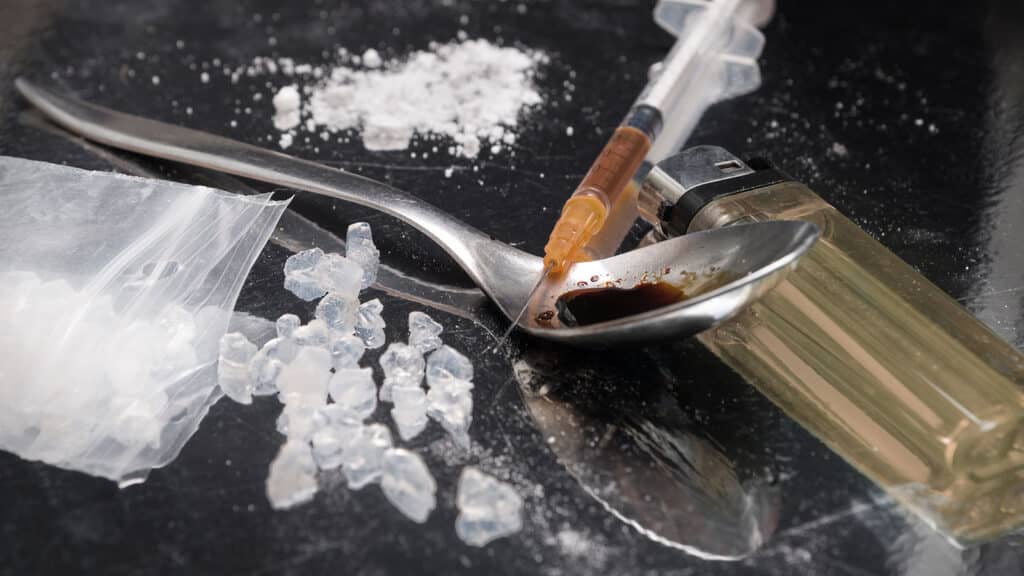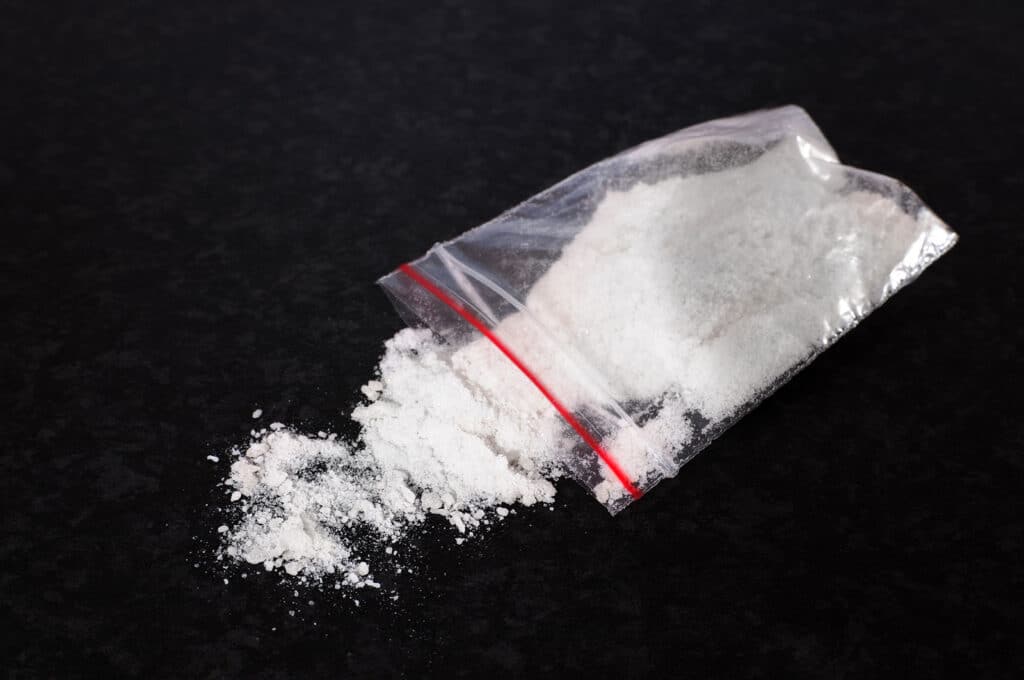According to Drug Abuse Statistics, nearly 100,000 people die of substance abuse in the US every year, killing almost a million people in just over two decades. Methamphetamine, also known as crystal meth, has been linked to a significant portion of these deaths.
Meth is a drug generally used as part of treatment programs involving Attention Deficit Hyperactivity Disorder (ADHD) in children and for treating obesity. Ingested outside medical prescription, the potent drug can have severe side effects, both mental and physiological.
The drug typically comes in pill, powder, or crystal form, and recreational use primarily involves smoking, swallowing, or injecting. But can you snort meth?

While insufflation is a common recreational way to administer drugs, there are several risks and dangers you may expose yourself to by taking methamphetamine outside a physician’s guidance.
Below, we’ll walk you through everything you should know about methamphetamine, including the risks and dangers of inhaling the drug. We’ll also share the best treatment options for people suffering from meth addiction and where to get the help you deserve.
Table of Contents
What is Methamphetamine?
Methamphetamine is a type of synthetic stimulant that belongs to the Schedule II stimulant drug classification, indicating its high potential for misuse and dependence. It primarily consists of pseudoephedrine, a standard over-the-counter cold medicine.
FDA-approved variant of the medicine comes in the brand name Desoxyn. It’s in pill form and is swallowed to ameliorate symptoms of ADHD in patients. But it’s worth noting that only a minority of ADHD individuals get a Desoxyn prescription, and only in smaller doses.
Street-manufactured meth are typically made and sold for recreational purposes. These illegal methamphetamine drugs are often misused by injecting, smoking, and snorting. They usually come as an odorless powder and are mixed with other (potentially toxic) substances.
Methamphetamine has been around for a long time. In the past, World War soldiers would take meth to stay awake and increase their focus on the battlefield. Others also use the substance to ease depression and promote weight loss.
However, using meth for whatever purposes is incredibly dangerous. Without professional guidance, ingesting the substance can harm the body and cause severe mental health problems.
How Does Meth Work?
As a stimulant drug, ingested meth travels through the bloodstream and enters the brain. After it enters the central nervous system, the drug triggers your neurotransmitters to release dopamine, the feel-good chemical that affects movement and motivation.
Besides your brain’s reward system, methamphetamine also affects your hippocampus, the area for memory and learning, the frontal and prefrontal cortex, which regulate judgement and reasoning, and the cerebellum, responsible for motor movements.
Why & How Do People Use Meth?
Many abuse methamphetamine to experience the high that comes with the surge of dopamine. They may also become energized, a fall sense of energy that allows their body to keep going without feeling fatigued.
They may also experience:
- Increased confidence
- Heightened focus
- Amplified sexual libido
- Diminished need for sleep
- Decreased appetite for food
- Rapid heart rate and elevated blood pressure
Those who ingested the drug by smoking report an intense rush of pleasurable feelings that lasts for a few minutes. People who inject the medicine directly into their bloodstream also feel a similarly fast onset of euphoric effects.
Snorting meth doesn’t have the same initial intense euphoria as injecting or smoking meth. The euphoric feeling they experience is also gradual and can take 3 to 20 minutes before the user notices its full effect.
Other methods of meth use include booty bumping or plugging, which involves dissolving crystal meth with liquid and spraying the mixture into the anus, and hot railing, which means melting the meth rock with heat and inhaling its vapor.

Snorting Meth: Dangers and Risks
Because of its less intense effects, some may falsely believe that snorting methamphetamine is the safer method of use with fewer health risks. But that’s not the case.
Methamphetamine use, regardless of method, remains dangerous, with a host of harmful health effects, including developing tolerance and addiction, or worse, meth overdose.
Physical Side Effects
Snorting meth comes with adverse physical effects. Ingesting the powdered substance through the nose can cause permanent damage to the nasal tissues, often called a “coke nose.” If meth use by insufflation becomes regular, the soft tissue damage will worsen.
Eventually, the deterioration in the nasal passages could develop into chronic complications, such as nostril, septum, and sinus irritations or infections. If you’re experiencing a frequent runny nose or nosebleeds, this could indicate sinus tissue damage from snorting meth.
Meth mouth is another health complication that could arise from meth abuse. This condition is characterized by dry mouth, tooth decay, loose teeth, gum disease, and black cavities caused by prolonged drug use.
Developing Tolerance and Methamphetamine Addiction
As meth hijacks the brain’s reward system, it makes the person taking the drug want to continue using, despite its dire consequences. Over time, their body can build tolerance after repeated use and will require higher doses to feel a similar rush as the first time they took meth.
By this time, the individual may start exhibiting meth withdrawal symptoms when reducing or ceasing substance use. This is called drug dependence, which can develop quickly after frequent and heavy drug use.
Compulsive drug-seeking behaviors typically follow after dependence occurs, altering and rewiring your brain to prioritize getting the substance over other facets of your life. This uncontrollable craving becomes one of the hallmarks characterizing substance use disorder.
How to Spot Methamphetamine Overdose
Taking too much meth leads to an increased risk of a toxic or deadly reaction. In one survey in 2021, they found nearly 33,000 people overdosed from ingesting dangerous doses of methamphetamine.
Here are some meth overdose signs to watch out for:
- Spiked heart rate
- Increased body temperature
- Elevated blood pressure
- Chest pains
- Circulatory collapse
- Stroke
- Seizures
- Kidney problems
- Heart attack
- Cardiovascular issues
- Altered mental state, including confusion and psychosis
Using methamphetamine alongside other illicit drugs, such as fentanyl, ecstasy, cocaine, and amphetamines, also significantly increases the risk of overdose fatality.
If you suspect any of your loved ones are showing any of these overdose signs, don’t hesitate to call 911 or go to the nearest hospital for immediate medical attention.

How Methamphetamine Abuse Changes You
Like other types of addiction, meth users can experience a myriad of physical, behavioral, emotional, and social issues. Interpersonal relationships typically take the brunt as those suffering from meth addiction shirk from their responsibilities and obligations.
Short-Term Effects
Although it’s unlikely to get dependent or addicted to methamphetamine after just a few uses, studies found alarming results after a single instance of exposure.
Depending on the dosage, people who took meth the first time immediately experienced adverse effects. Hyperthermia is among these symptoms, alongside rapid breathing and arrhythmia (irregular heartbeat), lasting several hours.
Some report nausea, restlessness, and tremors after their first meth intake. Meth comedown or crash also follows the initial high, which is characterized by severe fatigue, agitation, anxiety, and apathy.
Long-Term Effects
Long-term abuse of meth leads to significant damage to the brain’s neurotransmitters, particularly the cells that produce dopamine and serotonin. Ultimately, prolonged meth exposure can result in devastating cognitive and mental health disorders, such as:
- Chronic depression
- Aggressive behaviors
- Decreased motor skills
- Difficulty remembering and learning
- Anxiety and irritability
- Delusions and paranoia
- Severe memory loss
- Mood swings
- Auditory and visual hallucinations
While many of these symptoms are reversible with abstinence and intensive care, others may be permanent. The National Institute on Drug Abuse (NIDA) also found a link between developing Parkinson’s disease and chronic methamphetamine intake.
Meth Addiction Treatment Options
Because of its potency, meth addiction is one of the most challenging drug-related conditions to treat. Treatment centers typically employ a wide array of approaches to help those suffering from substance abuse overcome the disorder.
- Detoxification: This refers to the process of removing the drug from your system. Detox programs generally aim to assist SUD patients in managing withdrawal safely.
- Cognitive-Behavioral Therapy: CBT is an evidence-based treatment for substance use disorders. It helps patients identify and resolve unhealthy thought patterns that lead to addiction.
- Inpatient Rehab Programs: Inpatient rehab is the most intensive form of drug rehabilitation that involves living in a controlled environment to resolve SUD and other co-occurring disorders.

Final Thoughts: Where Can I Find Help?
Addiction is a complex and serious problem that affects not only the person suffering from the disorder but also the people surrounding them. Without proper guidance, breaking free from the grip of substance abuse can be a daunting battle.
Garden State Treatment Center is here to help. With flexible rehab programs, humane healthcare experts, and state-of-the-art treatment facilities, we help thousands of patients recover and maintain a life free from substance abuse.
Reach out to us and start your drug-free journey today!
References
- https://drugabusestatistics.org/drug-overdose-deaths/
- https://medlineplus.gov/druginfo/meds/a615002.html#why
- https://nida.nih.gov/research-topics/methamphetamine
- https://www.dea.gov/drug-information/drug-scheduling
- https://time.com/5752114/nazi-military-drugs/
- https://harmreduction.org/issues/overdose-prevention/overview/overdose-basics/recognizing-opioid-overdose/
- https://www.nytimes.com/2022/05/11/us/politics/overdose-deaths-fentanyl-meth.html
- https://pubmed.ncbi.nlm.nih.gov/29665491/
Published on: 2025-04-22
Updated on: 2025-04-26



